From the Manual Of
Tropical And Subtropical Fruits
by Wilson Popenoe
The Mango
Races And
Varieties
The classification of mangos must be considered from two distinct
standpoints. First, there are numerous seedling races; and second,
there are horticultural groups of varieties propagated by grafting or
budding.
The seedling races have not been studied in all parts
of the tropics. Most of those in America are now fairly well known, but
they are probably few compared to those of the Asiatic tropics. The
latter region has not been explored thoroughly.
So far as known,
all the seedling races are polyembryonic. Individuals reproduce the
racial characteristics with remarkable constancy. Numerous writers have
said that these races (incorrectly termed varieties) come true from
seed, and that there is no need of grafting or budding. There is enough
variation among the seedlings, however, to make some of them more
desirable than others. When one has been propagated by budding or
grafting it becomes a true horticultural variety.
The
classification of mangos has been discussed by Burns and Prayag in the
Agricultural Journal of India (1915); by P. H. Rolfs in Bulletin 127,
Florida Agricultural Experiment Station; and by the author in the
Proceedings of the American Pomological Society for 1915 and 1917.
The
abundance of grafted mangos has led Indian investigators to neglect the
seedling races. Doubtless some of the horticultural groups of grafted
varieties represent seedling races. C. Maries, in the Dictionary of the
Economic Products of India, grouped the named varieties with which he
was familiar in five "cultivated races." Probably some of these
represent seedling races. The antiquity of its culture in India and the
extensive employment of vegetative means of propagation have placed the
mango on a different footing from that which it occupies in regions
where it has been grown relatively a short time and propagated
principally by seed. In India, the horticultural varieties are most
prominent; elsewhere, seedling races are more in evidence.
The mangos of
the Malayan Archipelago have been less thoroughly studied, from a
pomological standpoint, than those of any other region. The botanist
Blume (Museum Botanicum Lugduno-Batavum) viewed them botanically, and
described as botanical varieties a number of forms which are in all
probability analogous to the seedling races of other regions. In
addition to races, there are a number of distinct species of Mangifera
in the Malayan region which bear fruits closely resembling true mangos.
These must be studied in connection with any attempt to straighten out
the classification of horticultural or pomological forms.
CochinChina
appears to be the home of a race of mangos which is unusual in
character, and which is certainly one of the most valuable of all. This
is the Cambodiana. By some botanists it is considered a distinct
species of Mangifera. It seems to be identical with the race grown in
the Philippine Islands. The latter has been carried to tropical
America, where it is known as Manila (Mexico) and Filipino (Cuba).
David Fairchild, who studied this race in Saigon, CochinChina, and
introduced it into the United States, describes it as a mango of medium
size, yellow when ripe, furnished with a short beak, and having a faint
but agreeable odor. The flesh varies from light to deep orange in
color, and is never fibrous. The flavor is not so rich as that of the
Alphonse, but is nevertheless delicious. One of the plants grown from
the seed sent to the United States by Fairchild has given rise to the
horticultural variety Cambodiana, now propagated vegetatively in
Florida.
There appear to be several different forms of this
race. Three forms are grown in the Philippines, where they are
distinguished by separate names. P. J. Wester states:
"There are
three very distinct types of mangos in the Philippines: the Carabao,
the Pico (also known as Padero), and the Pahutan, in some districts
called Supsupen and Chupadero. The Carabao is the mango most esteemed
and most generally planted." He further says, "Although uniform as
types, there is considerable variation in the form and size of the
fruit and presence of fiber and size of seed in both the Carabao and
Pico mangos, and careful selection will not only bring to light
varieties much larger than the average fruit of these types, but also
those having a much smaller percentage of fiber and seed than the
average fruit."
The seedling mangos of the Hawaiian Islands have
been given some attention by Higgins. In Bulletin 12 of the Hawaii
Agricultural Experiment Station he describes a number of them. Judging
from his illustration, the Hawaiian Sweet mango is the common seedling
race of the West Indies.
The French island of Reunion is said to
be the source of several seedling races which have been introduced into
tropical America. Paul Hubert1 says the mango
has become
thoroughly naturalized in this island. He mentions thirteen varieties
which are the most common; the names of several are the same as those
of well-known varieties in the French West Indies.
1 Fruits
des Pays Chauds.
Little is known of the mangos cultivated on the African coast and in
Madagascar.
The
seedling races of Cuba and those of Florida are practically the same,
seeds having carried from the former region to the latter. The
principal race is the one known in Cuba as mango (in contradistinction
to manga, the race second in importance), and in Florida as No. 11.
This is the common race of Mexico and many other parts of tropical
America. For convenience it may be termed the West Indian. The tree is
erect, 60 to 70 feet in height, with an open crown. The panicle is 8 to
12 inches long, with the axis reddish maroon in color. The fruit is
strongly compressed laterally, with curved and beaked apex. It is
yellow in color, often blushed with crimson; the fiber is long and
coarse, and the quality of the fruit poor, although the flavor is very
sweet.
The manga race of Cuba is less widely grown in other
regions, although it is well represented in Florida. The tree is
spreading, 35 to 40 feet high, with a dense round-topped crown. The
panicle is 6 to 10 inches long, stout, pale green in color, often
tinged with red. The fruit is plump, not beaked, yellow in color, with
long, fine fibers through the flesh. Two forms of this race are common,
manga amarilla and manga blanca. The former, known in Florida as
turpentine or peach mango, has an elongated fruit, deep orange yellow
in color, with bright orange flesh. The latter, known in Florida as
apple or Bombay mango, has a roundish oblique fruit, bright yellow in
color with whitish yellow flesh.
The Filipino (Philippine) race
probably reached Cuba from Mexico, and thence was carried to Florida.
It is the most delicious and highly esteemed of seedling mangos in all
of these regions. Indeed, it ranks in quality with many of the choice
grafted varieties from India. The tree is erect, 30 to 35 feet high,
with a dense oval crown. The panicle is 12 to 24 inches long, pale
green, sometimes tinged with red. The fruit is strongly compressed
laterally, sharply pointed rather than curved or beaked at the apex,
lemon-yellow in color, with deep yellow flesh almost free from fiber.
In Florida there are comparatively few trees of this race.
In
addition to the above, there are several other races of limited
distribution in Cuba. The biscochuelo mango of Santiago de Cuba is an
excellent fruit, worthy of propagation in other regions. The mango
Chino of the Quinta Aviles at Cienfuegos (a remarkable mango orchard
established years ago) is a large fruit always in great demand in
Habana markets. It is not, however, of rich flavor or fine quality.
Manga mamey, also of the Quinta Aviles at Cienfuegos is of better
quality than mango Chino, but is not so well known in Habana.
In
Jamaica the No. 11 race is esteemed above most other seedlings. It had
its origin in one of the grafted trees found on a captured French
vessel and brought to the island in 1782, as related on a foregoing
page.
The seedling races of Porto Rico have been treated in detail by G. N.
Collins1
and more recently by C. F. Kinman. The most prolific and popular race
is known as mango bianco. The mangotina is found near Ponce; it is
rather inferior in quality. The redondo is a seven-ounce fruit, lacking
in richness. The largo has a small oval fruit with much fiber. The name
pina is applied to several distinct forms, the commonest being a long
fruit of inferior quality. None of these Porto Rican forms seems to
merit propagation.
In Mexico the principal races are the common
West Indian, and the Manila or Filipino. The latter is grown
principally in the state of Vera Cruz. Its culture should be extended
to other parts of the country, as well as to other tropical countries
where it is not now grown.
1 Bull.
28, U. S. Dept. Agr.
There
is one race in Brazil which is of exceptional value. This is the manga
da rosa (rose mango), grown commercially in the vicinity of Pernambuco
and to a less extent at Bahia and Rio de Janeiro. While frequently
propagated by grafting, it is polyembryonic and should come true to
race when grown from seed. It is heart-shaped, slightly beaked; and of
good size. Its coloring is unusually beautiful. The fiber is coarse and
rather long, but not so troublesome as in many seedling races. The
flavor is rich and pleasant. This mango is believed to have been
brought to Brazil from Mauritius. The espada race of Brazil is of
little value : its fruit is slender, curved at both ends, green in
color, and of poor quality.
The horticultural varieties of the
mango are numerous. C. Maries reported having collected nearly 500, of
which 100 were good. Many of these were, however, of limited
distribution and little importance. More recent Indian writers catalog
from 100 to 200 varieties. The author has published in the Pomona
College Journal of Economic Botany (December, 1911) a descriptive list
of about 300, which includes the best-known from all parts of the
world. Some of these, however, are probably seedling races, not
horticultural varieties propagated by grafting or budding. Many writers
have made no distinction between races, in which the seedlings
reproduce the characteristics of the parent, and varieties, which can
be propagated only by vegetative means.
The confusion which
involves mango nomenclature in India is rather appalling. There can be
no doubt that in numerous cases the same name is applied to several
distinct varieties, and it is equally certain that one variety in some
instances has several different names. In addition, some of the kinds
catalogued by Indian nurserymen probably never existed outside of their
own imaginations. There are only a few varieties which are well known
and highly esteemed in India. Most of these have been introduced into
the mango-growing regions of the Western Hemisphere by the Office of
Foreign Seed and Plant Introduction of the United States Department of
Agriculture. The varieties described in the following pages are the
best which have been tested in Florida up to the present. Most of them
are well-known Indian sorts. They are few in number, but it is not
possible to include in such a work as this a fully complete list. The
classification here made into groups based on natural resemblances
throws related varieties together and should aid the prospective
planter to gain an idea of the more salient characteristics of each.
Only the most important varieties in each group are described.
Mango Mulgoba
Group
In
this group the tree is usually erect, with a broad, dense crown. The
leaves are slender, smaller (especially in the variety Mulgoba) than in
some of the other groups, the primary transverse veins 22 to 24 pairs,
moderately conspicuous. The panicle is usually slender, frequently
drooping, 12 to 18 inches in length, the axis and laterals varying from
pale green tinged pink to rose pink, the pubescence heavier than in
most other groups. The flowers are usually very abundant on the
panicle. The staminodes are strongly developed, often capitate, one or
two sometimes fertile. In general, varieties of this group require the
stimulus of dry weather to make them flower profusely, and they show a
decided tendency to drop most of their fruits. Haden, however, holds
its fruits well. The fruit is usually oval. It varies in color from
dull green to yellow blushed red, and lacks a distinct beak. The flesh
is deep yellow to orange-yellow, variable in quality. The seed is
normally monoembryonic.
Mulgoba (Fig. 15). - Form oblong ovate
to ovate, laterally compressed; size medium to above medium, weight 9
1/2 to 14 1/2 ounces, length 3 1/2 to 4 1/2 inches, breadth 3 to 3 1/2
inches, base flattened, with the stem inserted obliquely in a very
shallow cavity; apex rounded to broadly pointed, the nak a small point
on the ventral surface about 1/2 inch above the longitudinal apex;
surface slightly undulating, deep to apricot-yellow in color, sometimes
overspread with scarlet around base and on exposed side, dots few to
numerous, small, lighter in color than surface; skin thick, tough,
tenacious, flesh bright orange-yellow, smooth and fine in texture, with
a pronounced and very agreeable aroma, very juicy, free from fiber, and
of rich piquant flavor; quality excellent; seed oblong to
oblong-reniform, plump, with sparse, stiff, short fibers 1/2 inch long
over the surface. Season in Florida July to September.
Introduced
into the United States in 1889 from Poona, India, by the United States
Department of Agriculture. This was the first grafted Indian variety to
fruit in the United States. In attractive coloring, delicate aromatic
flavor, and freedom from fiber, Mulgoba is scarcely excelled, but it
has proved irregular in its fruiting habits and for this reason cannot
be recommended for commercial planting expect in regions with dry
climates. The tree does not come into bearing at an early age. The name
Mulgoba (properly Malghoba) is taken from that of a native Indian dish,
and means "makes the mouth water."
Haden (Fig. 16). - Form oval
to ovate, plump; size large to very large, weight 15 to 20 ounces,
sometimes up to 24 ounces, length 4 to 5 1/2 inches, breadth 3 1/2 to 4
1/2 inches, base rounded, the stem inserted almost squarely without
depression; apex rounded to broadly pointed, the nak depressed, 3/4
inch above the longitudinal apex; surface smooth, light to deep
apricot-yellow in color, overspread with crimson-scarlet, dots
numerous, large whitish yellow in color, skin very thick and tough;
flesh yellowish orange in color, firm, very juicy, fibrous only close
to the seed, and of sweet, rich, moderately piquant flavor; quality
good; seed oblong, plump, with considerable fiber along the ventral
edge and a few short stiff bristles elsewhere. Season in Florida July
and August. Originated at Coconut Grove, Florida, as a seedling of
Mulgoba. First propagated in 1910. The fruit is not so fine as that of
Mulgoba, but the tree is a stronger grower, comes into fruit at an
early age, and bears more regularly.
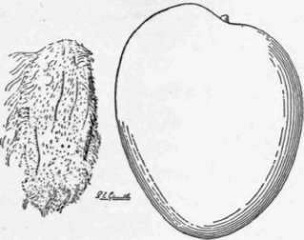
Fig. 15. The Mulgoba mango. (X 2/5)
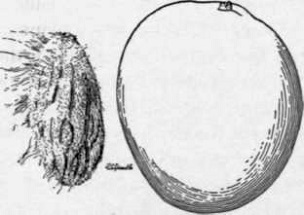
Fig. 16. The Haden mango. (X 1/3)
Mango. Alphonse
Group
The
trees of this group are usually broad and spreading in habit, but in a
few cases, e.g., Amini, they may be rather tall, with an oval crown.
The foliage is abundant, bright to deep green in color, the leaves
medium to large in size, with primary transverse veins 20 to 24 pairs,
fairly conspicuous. The panicle is large, very broad toward the base,
stiff, sometimes stout, 10 to 18 inches long, the axis and laterals
pale green to dull rose-pink in color, glabrate to very finely and
sparsely pubescent. The flowers are not crowded on the panicle. The
staminodes are poorly developed, rarely capitate. Most varieties of
this group are not heavy bearers. Flowers are often produced sparingly,
or on only one side of the tree, but a much higher percentage of
flowers develops into fruits than in the Mulgoba group. Under average
conditions, most of the varieties bear small to fair crops. The fruit
is longer than broad, usually oblique at the base, and lacks a beak.
The stigmatic point or nak often forms a prominence on the ventral
surface above the apex. The color varies from yellowish green to bright
yellow blushed scarlet. The flesh is orange colored, free from fiber,
and is characterized by rich luscious flavor, in some varieties nearly
as good as that of Mulgoba. On an average, the quality of fruit is
better than in any other group. The seed contains but one embryo.
Amini
(Fig. 17). - Form oval, laterally compressed; size small to below
medium, weight 6 to 8 ounces, length 3 to 3 1/4 inches, breadth 2 1/2
to 2 3/4 inches, base obliquely flattened, cavity none; apex rounded,
the nak conspicuous and 5/16 inch above the end of the fruit; surface
smooth, deep yellow in color overspread with dull scarlet particularly
around the base, dots numerous, small, pale yellow; skin thick and
firm; flesh bright orange-yellow in color, melting, very juicy,
strongly aromatic, free from fiber, and of sweet unusually spicy
flavor; quality excellent; seed oblong-oval, very thin, with only a few
short fibers on the ventral edge. Season in Florida June and July.
Introduced
into the United States in 1901 by the United States Department of
Agriculture (S. P. I. No. 7104) from Bangalore, India. One of the most
satisfactory Indian varieties tested in Florida and the West Indies. It
is more regular in bearing than many others, and the aroma and flavor
of the fruit are excellent. Not to be confused with Amiri, which has
sometimes been sold under the name Long Amini. Amin (Sanskrit) means a
tall, pyramidal mango tree; amin (Arabic) means constant, faithful.
Bennett (Fig. 18). - Form ovate-oblique to ovate-cordate, very plump;
size below medium to medium, weight 7 to 12 ounces, length 3 to 3 1/4
inches, breadth 2 3/4 to 3 3/4 inches, base obliquely flattened, cavity
almost none; apex broadly pointed, the nak level or slightly depressed,
about 3/4 inch above end of fruit; surface smooth, yellow-green to
yellow-orange, dots few, light yellow; skin thick and tough, not easily
broken; flesh deep orange, free from fiber, firm and meaty, moderately
juicy, of pleasant aroma and sweet, rich, piquant flavor; quality
excellent; seed oblong-reniform, thick, with short stiff fibers over
the entire surface. Season in south Florida late July and August.
Introduced into the United States in 1902 by the United States
Department of Agriculture (S. P. I. 8419 and 8727) from Goregon, near
Bombay, India. Syn. Douglas Bennett's Alphonse. This is one of the
esteemed Alphonse mangos of western India. Some of the fruits produced
in Florida have been characterized by hard sour lumps in the flesh,
hence the variety has not made such a favorable impression as would
otherwise have been the case. The tree is vigorous, and bears more
regularly than Mulgoba. The Alphonse mangos are supposed to have been
named for Affonso (Alphonse) d'Albuquerque, one of the early governors
of the Portuguese possessions in India. The name has been corrupted to
Apoos, Afoos, Hafu.
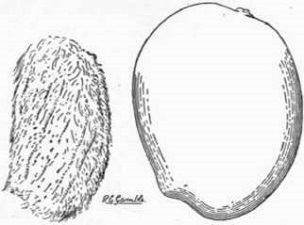
Fig. 17. Amini mango. (X about 1/2)
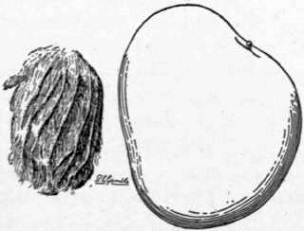
Fig. 18. The Bennett mango. (X 2/5)
Pairi
(Fig. 19). - Form ovate-reniform to ovate-oblique, prominently beaked;
size below medium to medium, weight 7 to 10 ounces, length 3 to 3 1/2
inches, breadth 2 7/8 to 3 1/4 inches; base obliquely flattened,
cavity none; apex rounded to broadly pointed, with a conspicuous beak
slightly above it on the ventral side of the fruit; surface smooth to
undulating, yellow-green in color, suffused scarlet around the base,
the dots few, small, whitish yellow; skin moderately thick; flesh
bright yellow-orange in color, firm but juicy, of fine texture, free
from fiber, of pronounced and pleasant aroma and sweet, rich, spicy
flavor; quality excellent; seed thick, with short bristly fibers over
the entire surface. Season in south Florida July and August. Introduced
into the United States in 1902 from Bombay, India, by the United States
Department of Agriculture (S. P. I. 8730); a variety (S. P. I. 29510)
introduced under the same name in 1911 from Poona, India, has proved to
be slightly different. Syns. Paheri, Pirie, Pyrie. Ranks second only to
Alphonse in the markets of Bombay, India. William Burns says,
"Personally I prefer the slightly acid Pairi to the heavier and more
luscious Alphonse." Two subvarieties are known in India, Moti Pairi and
Kagdi Pairi. The tree is a good grower, and resembles Bennett in
productiveness, although it sometimes fruits more heavily. The word
Pairi is probably a corruption of the Portuguese proper name Pereira.
Rajpuri.
- Form roundish ovate to ovate-reniform, beaked; size below medium to
medium, weight 8 to 12 ounces, length 3 1/4 to 3 3/4 inches, breadth 3
to 3 1/2 inches; base flattened, scarcely oblique, cavity none; apex
bluntly pointed, with the prominent nak to one side; surface smooth,
green-yellow to yellow in color, over-spread with scarlet on exposed
side and around base; dots small, numerous, whitish; skin moderately
thick; flesh deep yellow in color, free from fiber, juicy, with
pronounced aroma and rich piquant flavor; quality excellent; seed
oblong-elliptic, thick, with short stiff fibers over the surface.
Season July and August in Florida.
Introduced
into the United States in 1901 from Bangalore, India, by the United
States Department of Agriculture (S. P. I. 7105). Syns. Rajpury,
Rajapuri, Rajabury, and Rajapurri. A fruit of fine quality, with aroma
and flavor distinct from that of other mangos. Its fruiting habits have
proved fairly good. Rajpur, name of a town in India (perhaps Rajapur?).
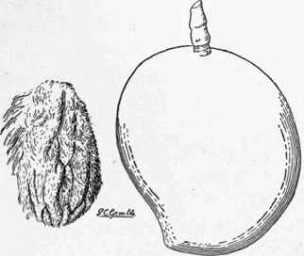
Fig. 19. The Pairi mango. (X 2/5)
Mango. Sandersha
Group
The tree is erect, stiff, with the crown less broad than in the
Mulgoba group and usually not so umbrageous. The foliage is fairly
abundant, deep green in color, the leaves comparatively small but
broad, with primary transverse veins 18 to 24 pairs, moderately
conspicuous. The panicle is small to large, broad toward the base, 8 to
18 inches long, stiff, the axis and laterals deep magenta-pink to
bright maroon, the pubescence very minute and inconspicuous. The
flowers are abundant but not closely crowded on the panicle. The
staminodes are weakly developed, rarely capitate or fertile. Varieties
of this group often flower in unfavorable weather, and they remain in
bloom during a long period. On the whole, the group is characterized by
a higher degree of productiveness than any other class of Indian mangos
yet grown in the United States. The fruit is long, usually tapering to
both base and apex and terminating in a prominent beak at the apex,
large in size, deep yellow in color, the flesh orange-yellow, and free
from fiber. The somewhat acid flavor makes the mangos of this group
more valuable as culinary than as dessert fruits. The seed is long,
containing normally one embryo, the cotyledons often not filling the
endocarp completely.
Sandersha (Fig. 20). - Form oblong,
tapering toward stem and prominently beaked at the apex; size large to
extremely large, weight 18 to 32 ounces, length 6 1/2 to 8 inches,
breadth 3 3/4 to 4 1/4 inches; base slender, extended; apex broadly
pointed, with the nak forming a prominent beak to the ventral side;
surface smooth, yellow to golden yellow in color, sometimes blushed
scarlet on exposed side, dots numerous, small, yellow-gray; flesh
orange-yellow in color, meaty, moderately juicy, free from fiber, and
of subacid, slightly aromatic flavor; dessert quality fair, culinary
quality excellent; seed long, slender, slightly curved, with fiber only
along the ventral edge. Season in south Florida August and September.
Introduced
into the United States in 1901 from Bangalore, India, by the United
States Department of Agriculture (S. P. I. 7108). Syns. Soondershaw,
Sandershaw, Sundersha. A variety introduced from Saharanpur, India,
under the name Sundershah (S. P. I. 10665) is probably distinct. The
tree has remarkably good fruiting habits. Etymology of name unknown.
Totapari.
- Form oval to ob-long-reniform, beaked; size medium, weight 10 to 12
ounces, length 4 1/5 to 5 inches, breadth 3 to 3 1/2 inches; base
rounded, the stem inserted squarely; apex broadly pointed, with the nak
forming a prominent beak to the ventral side; surface smooth, greenish
yellow in color, overspread with scarlet on exposed side; skin
moderately thick and tough; flesh bright yellow in color, unusually
juicy, free from fiber, moderately aromatic, and of subacid, moderately
rich flavor; dessert quality fair, culinary quality good; seed oblong,
rather thin, with small amount of fiber on edges. Season in south
Florida August and September.
Introduced into the United States
in 1902 from Bombay, India, by the United States Department of
Agriculture (S. P. I. 8732). Syn. Totafari. The tree does not bear as
well as Sandersha, nor is the fruit quite as good. The name means
"parrot's beak."
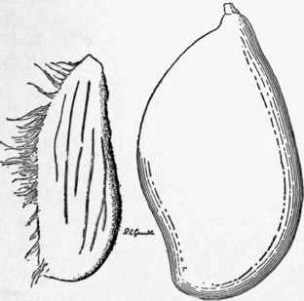
Fig.
20. The Sandersha mango. The fruit is not so richly flavored as that of
Mulgoba or Pairi, but is excellent for cooking. (X 1/3)
Mango.
Cambodiana Group
In
this group the tree is erect, with the crown usually oval, never
broadly spreading, and densely umbrageous. The foliage is abundant,
deep green in color, the leaves medium sized to rather large, with
primary transverse veins more numerous than in other groups, commonly
26 to 30 pairs, quite conspicuous. The odor of the crushed leaves is
distinctive. The panicle is very large, loose, slender, 12 to 20 inches
in length, and laterals pale green to dull magenta-pink, very finely
pubescent. The staminodes are poorly developed, rarely capitate or
fertile. The varieties of this group usually bloom profusely; those
from Indo-China are productive, while the Philippine seedlings in
Florida sometimes bear excellent crops and in other seasons drop all
their flowers. Three to five fruits, or even more, may develop on one
panicle. In form the fruits are always long, strongly compressed
laterally, and usually sharply pointed at the apex, lemon-yellow to
deep yellow in color, with bright yellow flesh almost free from fiber
and of characteristic sprightly subacid flavor, lacking the richness of
some of the Indian mangos. The seed is oblong, normally polyembryonic.
Cambodiana
(Fig. 21). -Form oblong to oblong-ovate, compressed laterally; size
below medium to medium, weight 8 to 10 ounces, length 3 3/4 to 4 1/2
inches, breadth 2 1/2 to 2 3/4 inches; base rounded, the stem inserted
squarely or slightly to one side without depression; apex pointed, the
nak a small point 1/2 inch above the longitudinal apex; surface smooth,
yellow-green to deep yellow in color, dots almost wanting; skin very
thin and tender; flesh deep yellow in color, very juicy, free from
fiber, and of mild, subacid, slightly aromatic flavor; quality good;
seed elliptic-oblong, thick, with short fiber on ventral edge. Season
in Florida late June to early August.
Originated at Miami,
Florida, from a seed introduced in 1902 from Saigon, CochinChina, by
the United States Department of Agriculture (S. P. I. 8701). A later
importation of seeds from the same region (S. P. I. 11645) has given
rise to another variety propagated by budding which differs slightly
from the one here described. The tree bears more regularly than most of
the Indian varieties. Named for Cambodia, a region of French Indo-China.
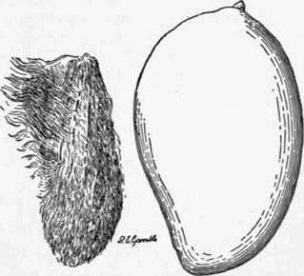
Fig. 21. The Cambodiana mango. (X 1/3)
The
Mango
Botanical
Description
History and
Distribution
Composition
And Uses Of The Fruit
Climate
And Soil
Cultivation
Propagation
The Mango Flower
And Its Pollination
The
Crop
Pests And
Diseases
Races and
Varieties
Back to
The Mango Page
|
|